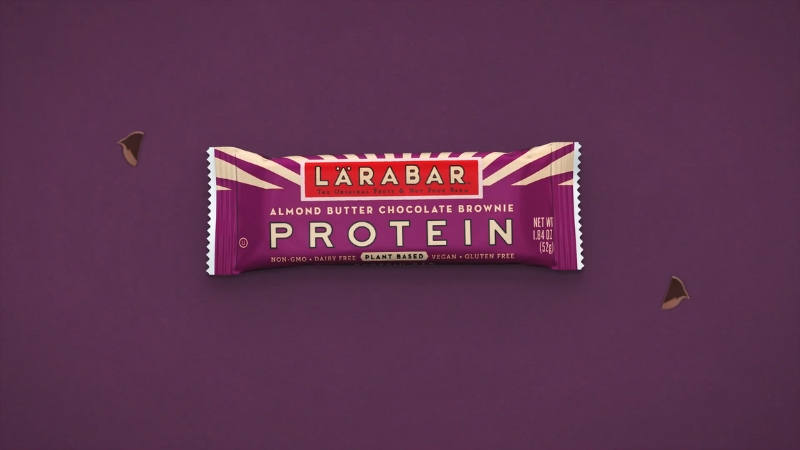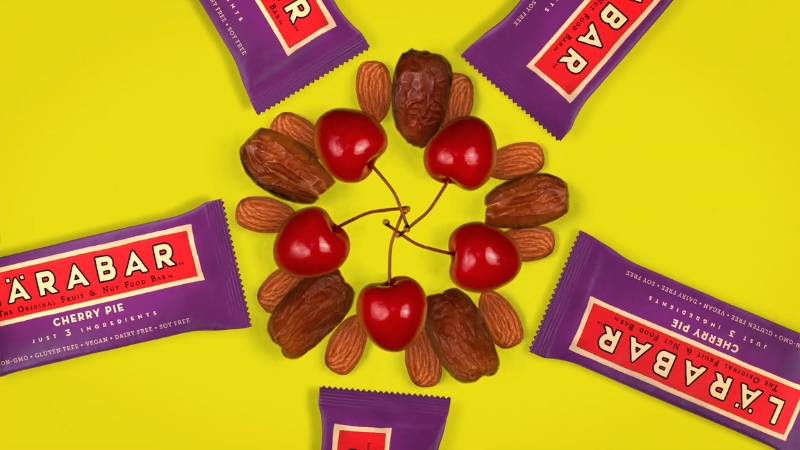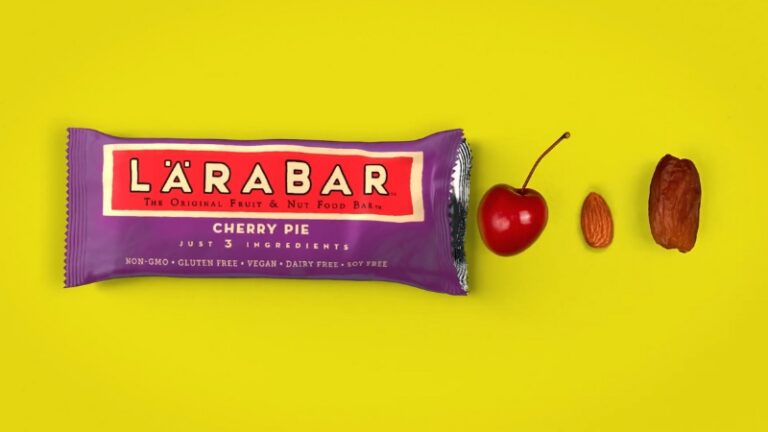Larabars market themselves as clean, simple, and natural. They contain only a handful of ingredients, usually fruits, nuts, and spices, and the brand emphasizes “real food” over additives or artificial sweeteners.
But nutritional marketing often hides nuance. A bar can be made from wholesome ingredients and still act metabolically like a candy bar if its sugar content spikes insulin and provides minimal protein or fiber to slow digestion.
On average, a Larabar contains around 200 calories, 17–20 grams of sugar, 4–6 grams of protein, and 3–5 grams of fiber. Those numbers sit surprisingly close to popular chocolate bars: a Snickers (52g) has 250 calories, 27 grams of sugar, and 4 grams of protein.
The difference lies in source dates instead of refined sugar, but physiologically, glucose is still glucose. Whether your body receives it from cane sugar or fruit puree, the impact on blood sugar levels remains similar.
Ingredient Simpcity, Marketing or Meaning?

Larabars built their reputation on transparency: labels list items like dates, almonds, cashews, cocoa powder, and sea salt, no syrups, no emulsifiers. This ingredient’s honesty is legitimate.
Most Larabars contain fewer than 10 components, often as few as three. In a market full of soy isolates and maltodextrin, that simplicity appeals to consumers looking for recognizable food.
However, simplicity is not the same as balance. The heavy reliance on dates or other dried fruits means more than half the calories come from sugar.
Natural sugar remains sugar, and its concentration in dried fruit can rival that of processed sweets. The fiber and micronutrients in dates temper absorption slightly, but not enough to prevent a significant blood-sugar rise.
Nutritional Comparison (per bar)
Product
Calories
Sugar (g)
Protein (g)
Fiber (g)
Fat (g)
Larabar (Cashew Cookie, 48g)
200
18
5
3
9
Larabar (Chocolate Chip Brownie, 45g)
190
17
4
4
8
Snickers (52g)
250
27
4
1
12
RXBar (Chocolate Sea Salt, 52g)
210
13
12
5
9
Kind Bar (Dark Chocolate Nut, 40g)
180
8
6
7
14
The Sugar Debate – Natural vs. Refined
The distinction between natural and refined sugar matters only marginally in metabolism. Both deliver glucose and fructose, which raise blood sugar and trigger an insulin response.
Larabars avoid high-fructose corn syrup and artificial sweeteners, but most of their sweetness still comes from dates and raisins, which are roughly 65–70 % sugar by weight.
For sedentary individuals, that much fast-digesting carbohydrate produces short-term energy but limited satiety. Within 60–90 minutes, blood sugar falls, leading to renewed hunger.
The glycemic load of many Larabar varieties approaches that of sweetened granola bars. The clean-ingredient profile doesn’t change how the pancreas interprets that sugar surge.
Protein and Satiety
Protein is the missing element. The average Larabar provides 4–6 grams, roughly one-quarter of the minimum per-snack target for maintaining stable energy.
For comparison, protein-forward bars like RXBar or Quest Bar deliver 12–20 grams. This protein gap explains why many users report feeling hungry again soon after eating a Larabar.
Athletes who use Larabars as pre-workout fuel may benefit from the rapid sugar absorption, but for general snacking, it functions more like a sweet treat. The lack of significant protein or fat slows neither digestion nor appetite rebound.
Micronutrient Reality
Because the bars rely on whole fruits and nuts, they contain trace minerals, magnesium, potassium, and small amounts of iron. A single Cashew Cookie Larabar offers 5–7 % of the daily magnesium requirement and 200 mg of potassium.
Yet these benefits are minor compared to a serving of fresh fruit or mixed nuts. The drying process reduces vitamin C and water content, leaving calorie density high and nutrient density modest.
How They Compare in Energy Quality
From a sports-nutrition standpoint, Larabars occupy the middle ground between real food and candy. They deliver quick energy and are digested easily before a workout or endurance event.
For office workers or students, though, that same property can cause energy crashes by mid-afternoon.
Metabolic Impact Estimate
Snack Type
Glycemic Load (approx.)
Energy Duration
Suitable Context
Fresh Apple + Almonds
10
2–3 hrs
Balanced snack
Larabar
18–22
1–1.5 hrs
Pre-workout fuel
Snickers
21
1 hr
Indulgence
RXBar
14
2 hrs
Meal replacement
Oatmeal + Peanut Butter
12
3–4 hrs
Sustained energy
Real vs. Perceived “Clean Eating”
View this post on Instagram
Larabars align with the clean-label movement, with no artificial coloring, gluten, or dairy. That transparency fosters consumer trust, but it often blurs into health halo bias.
People equate “organic” or “real” ingredients with “healthy outcome.” In reality, the calorie and sugar composition drives metabolic response more than branding language.
If a bar derives 60–70 % of calories from sugar and provides minimal protein or fiber, its effect on blood glucose mirrors a confectionery snack. The origin of sugar doesn’t change that biochemical fact.
When Larabars Make Sense
- Quick Energy Before Exercise: The high sugar load offers immediate fuel. Endurance athletes and runners often prefer them for digestibility.
- Emergency Snack: When the alternative is vending-machine candy, a Larabar is less processed and contains no synthetic additives.
- Travel Convenience: Better shelf life than fresh fruit, suitable for short-term hunger management.
They fail, however, as a balanced meal substitute. Without sufficient protein or slow carbs, they do not maintain energy or muscle recovery.
The Broader Perspective
The rise of snack bars reflects a broader food culture of convenience over preparation. Consumers outsource nutrition decisions to branding cues, short ingredient lists, minimal packaging, and “plant-based” claims.
Larabars exploit that psychology effectively. They are not deceptive; they are strategically incomplete.
A Snickers appeals to indulgence; a Larabar appeals to virtue. Metabolically, they share similar outcomes when used in the same context. The difference is emotional framing, not biochemical performance.
Summary Evaluation
Factor
Larabar
Candy Bar (Snickers)
Protein Bar (RXBar)
Ingredient Transparency
Excellent
Poor
Moderate
Sugar Source
Natural (dates)
Refined (corn syrup)
Natural + Added
Protein Support
Low
Low
High
Glycemic Load
High
High
Moderate
Satiety
Short
Short
Moderate
Suitable Use
Pre-workout / quick snack
Treat
Meal supplement
Final Assessment

Larabars are not junk food, but they are not a health food either. They represent an upgrade from candy in ingredient quality, not in metabolic impact.
Their sugars are unrefined but abundant; their nutrients are natural but limited. For quick energy, they work. For balanced nutrition, they fail.
Some foods, like hominy, raise a similar question – is hominy healthy or just a trendy filler – and the answer often depends on context, portion size, and overall diet balance.
The idea of a “clean candy bar” describes them best: real ingredients with candy-level sugar behavior. Whether that counts as healthy depends less on marketing and more on how nd when you eat them.

